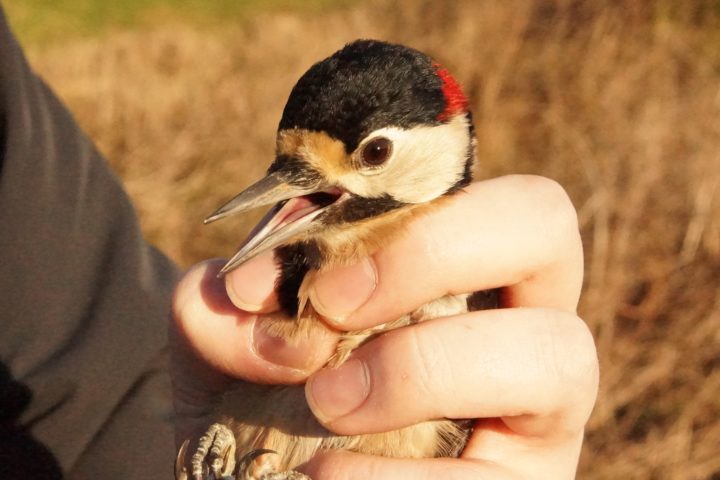I have had some returns from the BTO of ‘Controlled’ Barn Owls including an amazing report of an owlet ringed in June 2014 near Thropton in Northumberland which has taken up residence as a female adult in Ruthin, North Wales! It was first retrapped by a local ringer in July but it’s fair to say that there was a fear that there had been some sort of mistake. However, on the 31st December 2018 it was captured again and with a member of BTO staff present, it was confirmed as being Barn Owl FH92017. It’s travelled at least 265 km’s (and probably a lot further since that’s a straight line course!). This owl is still alive while three more are unfortunately not: GR03144 was ringed in its nest in June 2016 near Wooler and was found dead as a Road Casualty at Swinwood Mill, Scottish Borders on the 28th December; GV23125 ringed its nest east of Wooler in June 2015 was also found dead near Stannington on the 3rd December 2018; and one of this years rare young ringed near Warkworth in June 2018 was found dead at Alnmouth Bay in October.
Other birds still alive include a Mute Swan cygnet ringed (with a large red darvik ring with white letters ZJU) at Howick in September 2017 which is living this winter at Queen Elizabeth Country Pk, Woodhorn. Also a Tree Sparrow that we controlled alive near East Linden on the 6th January S225037; was actually ringed at Whitburn Country Pk on the 17th September 2018.
We actually undertook eight ringing sessions near East Linden from the end of November 2018 until the 6th Jan 2019 capturing a total of 261 birds (185 new and 76 retraps). On the last session we recaptured a Willow Tit, first ringed 12 months ago; showing unusually ‘white’ tertial feathers (see attached picture); and a noisy male Great Spotted Woodpecker hatched in 2018 (see attached). The species were: Blue Tit, Robin, Dunnock, Coal Tit, Willow Tit, Chaffinch, Greenfinch, Great Tit, Long Tailed Tit, Tree Sparrow, Great Spotted Woodpecker, Blackbird, House Sparrow, Marsh Tit, Starling and Nuthatch. We captured 4 Marsh Tits (2 were new juveniles and the other 2 were adult retraps from last winter). We also captured 6 Willow Tits including 4 new birds (2 juvenile and 2 adult) and 2 adults from last winter. Both Marsh and Willow Tits are rare and declining species; although in Northumberland (but not nationally) the Willow Tit seems to be more numerous. The Rare Birds Breeding Panel and RSPB are organising a national survey for Willow Tits (and Marsh Tits) in 2019 and 2020 and if anyone reading this is interested in participating (principally from February – April) then please get in touch and I can provide you with contact information for the organisers.

The rather mixed, often wet and windy weather had led to some poor conditions for ringing in January but one of my trainees has just achieved his C permit (congratulations to Jason) so is now helping me with those less experienced, including a new starter who lives locally. The 2nd January saw 4 Long Tailed Tits cram into an ‘open’ trap in my garden and being relatively easily captured by hand – as they were so keen to feed on some fat balls. A proper session with trainees on the 4th netted 28 new birds including a male Bullfinch and 7 new Long Tailed Tits; together with 14 retraps; including two Blue Tits first ringed as juveniles in 2016. A breeze on the 18th kept the catch down to only 9 new birds and 14 retraps. Included in the new birds was a male Blackbird with such a black bill that it was probably a Scandinavian migrant. Most interesting were the Great Tit that was originally ringed as a juvenile in 2016; and a Siskin ringed in April 2018 (as an adult). This Siskin is probably on its way further north.
Ringing again on the 20th we caught 18 new birds including a male Nuthatch; and 17 retraps which included a Siskin first ringed as an adult in February 2017 and another from March 2017; and a ‘resident’ Nuthatch (probably a female) which we first ringed on the 1st December last year.
Finally can I recommend that anyone interested in birds should get hold of the recently published: “2017 Birds in Northumbria” published by the Northumberland & Tyneside Bird Club (details on their web-site).
Anyone interesting in ringing is invited to get in touch.
Phil Hanmer ‘A’ Ringer/Trainer; Natural History Society of Northumbria Ringing Group (Hancock Museum)
E-mail: tytoalbas@btinternet.com